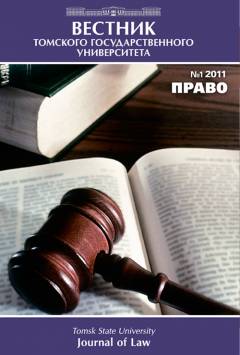Influence of an ecological factor on the content of modern law of neighboring tenements: some problems and ways of their decision
Being the institute of private law in Ancient Rome, the law of neighboring tenements underwent essential transformations during the next centuries. The problems of modern neighboring tenements law have all signs of complexity, and their due regulation is possible only by synthesis of achievements and methods of various social, humanitarian and other sciences. The dynamics of resettlement of population has the impact on the emergence of huge cities -megalopolises where millions of people live at the same time. This results in the formation of new kinds and types of relations between neighbors including the conflicts between neighbors-residents of blocks of flats, placement of underground objects, solar rights of neighbors and damage by nanotech-nologies. It is obvious that no universal legal mechanism for resolving all conflicts between neighbors can exist in principle. Therefore, we can speak about the development of a complicated system of checks and balances, which includes both classical Roman mechanisms and public methods for resolving conflicts that were elaborated in the epoch of globalization. In relation to Russia not only the introduction of amendments to the Civil Code, but the development of public control system, the implementation of the system of neighbors' mediation and the enlargement of local bodies' powers could decrease the tension of neighbors' problems. Moreover, the need to develop public methods for the regulation of relations between neighbors does not mean total disregard of the Roman idea of tolerance in disputes between neighbors, the need "to endure the actions of neighbors". We speak about further development of the criteria of inadmissible actions taking into account new requirements of life, a subsidiary application of the existing norms and rules as the basic criteria of admissible actions in relations between neighbors.
Keywords
соседские споры,
законопроект,
сельское хозяйство,
зонирование,
животноводческие фермы,
жилая застройка,
шум,
запах,
климат,
нанотехнологии,
disputes between neighbors,
bill,
agriculture,
zoning,
livestock farms,
housing estate,
noise,
smell,
climate,
nanotechnologiesAuthors
| Anisimov Aleksey P. | Volgograd Institute of Management - a branch of the Russian Academy of National Economy and Public Service under the President of the Russian Federation | anisimovap@mail.ru |
Всего: 1
References
Законопроект № 47538-6 «О внесении изменений в части вторую и четвертую Гражданского кодекса Российской Федерации и признании утратившими силу законодательных актов (отдельных положений законодательных актов Российской Федерации)». URL: http:// asozd2. duma.gov.ru/main. nsf/%28SpravkaNew%29?OpenAgent&RN=47538-6&02 (дата обращения: 29.04.2016).
Апелляционное определение Верховного суда Республики Башкортостан от 18 декабря 2014 г. по делу № 33-18100/2014 // СПС «КонсультантПлюс» [Электронный ресурс] (дата обращения: 29.04.2016).
Апелляционное определение Московского областного суда от 27 августа 2014 г. по делу № 33-18883/2014 // СПС «КонсультантПлюс» [Электронный ресурс] (дата обращения: 29.04.2016).
Апелляционное определение Краснодарского краевого суда от 9 сентября 2012 г. по делу № 33-20323/2012 // СПС «КонсультантПлюс» [Электронный ресурс] (дата обращения: 29.04.2016.
Постановление Арбитражного суда Западно-Сибирского округа от 19 марта 2015 г. по делу № А46-7540/2014 // СПС «Консультант плюс» [Электронный ресурс] (дата обращения: 29.04.2016).
Определение Высшего Арбитражного Суда РФ от 13 января 2014 г. № ВАС-16030/13 // СПС «КонсультантПлюс» [Электронный ресурс] (дата обращения: 29.04.2016).
Определение Верховного Суда РФ от 25 мая 2015 г. № 309-ЭС15-5293 // СПС «КонсультантПлюс» [Электронный ресурс] (дата обращения: 29.04.2016).
Sommers L. A Practical Guide to Measure 37 // Journal of Environmental Law and Litigation. 2005. Vol. 20. P. 218-219.
Loshin J. Property in the Horizon: The Theory and Practice of Sign and Billboard Regulation // Environs. 2006. Vol. 30. P.144-153.
Lewyn M. Yes to Infill, no to Nuisance // Fordham Urban Law Journal. 2015. Vol. XLII.
Kramer B.M. Local Land Use Regulation of Extractive Industries: Evolving Judicial and Regulatory Approaches // Journal of Environmental Law. 1996. Vol. 14.
Murphy L.B. CAFO Grief: Using Tax Grieving Procedures to Protest Industrial Animal Factories // Journal of Environmental Law and Litigation. 2008. Vol. 23.
Johnson J.E. Environmental Stigma Damages: Speculative Damages in Environmental Tort Cases // Journal of Environmental Law. 1996/97. Vol. 15.
Sarlo C.H. A Comparative Analysis: The Affirmative Defense of an Innocent Landowner versus the Prima Facie Case of a Toxic Tort Plaintiff: Can CERCLA's Innocent Landowner Provision Be Used as a Defense in a Toxic Tort Suit? // Pace Environmental Law Review. 1999. Vol. 16. № 2. P. 272-278.
Apple B.E. Mapping Fracking: an Analysis of Law, Power, and Regional Distribution in the United States // Harvard Environmental Law Review. 2014. Vol. 38.
Pensley D.S. The Legalities of Stream Interventions: Accretive Changes to New York State's Riparian Doctrine Ahead? // Pace Environmental Law Review. 2008. Vol. 25.
Klass A.B. Property Rights on the New Frontier: Climate Change, Natural Resource Development, and Renewable Energy // Ecology Law Quarterly. 2011. Vol. 38. P. 97-103.
Сылкина С.М. Международно-правовые аспекты рационального использования альтернативных источников энергии. URL: http://rusnauka.com/Page_ru.htm (дата обращения: 09.04.2016).
Walker R.K. The answer, my friend, is blowin' in the wind: nuisance suits and the perplexing future of American wind farms // Drake Journal of Agricultural Law. 2011. Vol. 16.
Анциферова И.В. Источники поступления наночастиц в окружающую среду // Вестн. Перм. национ. иссл. политех. ун-та. Машиностроение, материаловедение. 2012. Т. 14, № 2. С. 54-66.
Morriss A.P., Meiners R.E. Market Principles for Pesticides // William & Mary Environmental Law and Policy Review. 2003. Vol. 28. P. 67-70.
